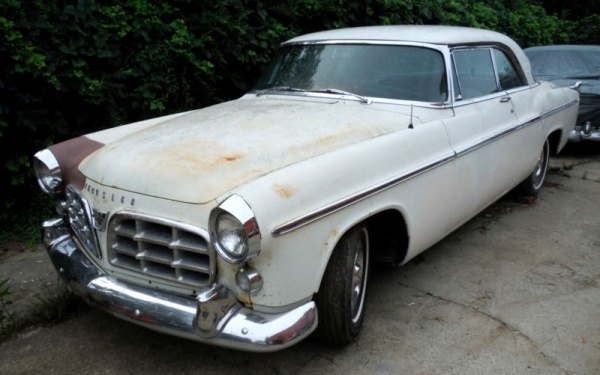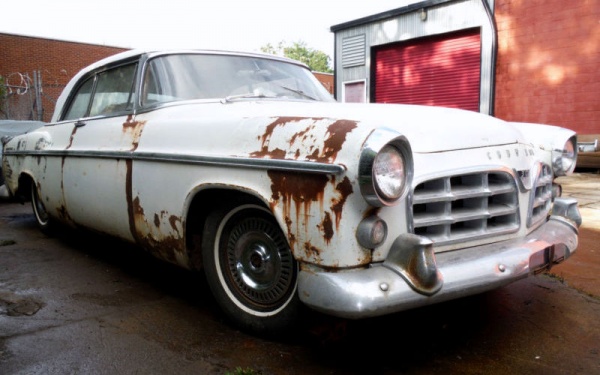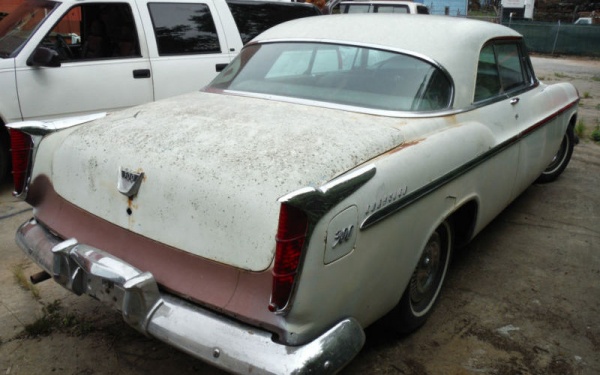The styling of the American luxury car market of the 1950’s can easily be described in one word, “tailfins”. Cadillac, Lincoln, and Chrysler were all competing to see who could build the biggest fins, claiming it helped with aerodynamics. With the major brands all offering similar designs, Virgil Exner knew Chrysler needed something to differentiate it from the crowd, so he introduced what he called the “Forward Look”. The first car to feature his new look was the 1955 Chrysler C-300, which wasn’t just luxurious and stylish, but also offered impressive performance. While the design was a success, there were only 1,700 built in ’55 and these early 300s are becoming difficult to find today. The seller of this ’55 has another complete, but rusty one, and is including both in one sale. Find them here on eBay.
As you can see, the other car is very rusty, but could be saved. Both cars are complete and have all the rare parts with them. Chrysler wanted the new car to be more than just a luxury vehicle, so they dropped their 331 cui Hemi V8 into the engine bay. With dual four barrel Carter carburetors, the Hemi engine was good for 300 horsepower and made it a fierce competitor in NASCAR.
The low roof line, long hood, and sleek look of Exner’s Forward Look design set the 300 apart from the rest of the finned cars it competed with and is still impacting automotive design today. These two cars are in need of some serious work, but we think they would be worth saving. Not only are they iconic, but they have Hemi power!




Magnificent. The significance of the 300-letter series cannot be overstated, particularly when it’s shrouded in this superb body; and this model is the one that started all the fuss. I don’t know where values are for these, but this one definitely looks like its worth saving. An iron fist in a velvet glove.
Don,
I have read and greatly appreciat your posts on Curbside Classic on so many different autos.
I wanted to ask you something regarding something different.
In your article regarding Delorean you mentioned that you were in advertising. I presumed that you may have been in the auto side of things.
If so did you ever know Rich Anderman? He had a great career in that biz. My brother grew up with him but they lost touch in their later life. He passed away recently and I’ve not been able to see an obit.
Just wondering as you do seem to know a lot about the industry and it’s leaders.
The only thing that will limit this sale is that it’s only for someone who has enough time, money and space for buying and restoring TWO cars! An enviable position to be in, in my opinion!
I worked for a guy a very long time ago who had one of these in a wagon & it was a parts runner the car was all there but a little tired however when you started this car the engine was amazing, smooth, quiet & powerful. I really like these.
I WOULDN’T SWEAR TO IT, BUT WHEN THE 1955 CHRYSLER 300 CAME OUT, IT WASN’T A 300C, JUST A PLAIN 300, AS THE FIRST ONE. THEN CAME B, C, ETC.
It isn’t a Chrysler 300C; those were the ’57s. This is a Chrysler C-300.
I’m probably in a minority here but I think the 300C is the first US musclecar, and one would be my top choice for a ’50s US performance car to own.
Yes, I know about the early OHV V8 Oldsmobiles. A family member bought a ’53 Olds with standard transmission brand new and it definitely moved along. But the 300C with dual quads and pretty good handling had more muscle than other US cars and really established the idea of a US car that had performance as its main goal.
What I don’t understand here is why sell both 300s together? That will probably limit the number of potential buyers compared to selling them separately, especially since both are said to be complete. But these are so appealing and there are so few of these first year letter cars around that I’m guessing that these will be bought and restored one way or another. I hope one ends up at one of the summer car shows near me.
I agree with you Dolphin. Whilst the Olds V8 was an option across a range of models, the C-300 was a model in its own right. Definitely a progenitor of the musclecar species, and with so few made both of these should be preserved in any way the new owner/s see fit.
i like more then 1 car in a listing. gives the new owner more options. on this one maybe the seller will take an offer on just one of the cars.
Calling the 300 a musclecar is to most a stretch. By popular definition, musclecars appeared when an engine from a full sized car was provided by the factory in that manufacturer’s smaller bodied car, if one existed. It’ like calling a ’66 Galaxie 427 a musclecar, when indeed the Fairlane GTA 390 and 427s were the musclecars. Also, by wide acclaim (and old advertising copy) the Forward Look officially began in 1957. I had a 1955 Windsor and to this day it is an ugly car. Merely having a high performance engine in a full sized car resulted in a fast car, sometimes referred to as a superstock or ultrastock (both drag race name). But the neither the factory nor the auto journalists at the time ever had a special monicker for a 413 Plymouth, a 421 Pontiac nor a 406 Ford back in 1962 for instance. Even the 1957 Rambler Rebel which had the V8 from the big car in a small Rambler was not called a musclecar even by the most obvious source itself, the AMC factory! Musclecars began in 1964 without a doubt.
I think it’s a general term these days, a big thirsty engine.
Jeff, it’s probably splitting hairs a bit, but I think Dolphin’s point still stands. This was a car whose model name and marketed identity was based upon its power output, thereby establishing its credentials as a performance series. Whether or not it should be called a ‘muscle car’ retroactively is akin to refusing to acknowledge The Great War as World War 1. Muscle cars in the US found their ultimate expression in the mid size and compact ranges, but as a consumer mindset the idea really started with the C-300.
I get your point, but the claims for the first musclecar or the first year of musclecars vary, just like the claims about the first US sports car—Stutz Bearcat? Crosley Hotshot? C1? Take your pick.
Sometimes the ‘first’ of something doesn’t look exactly like what the ultimate of that thing ends up being like. When I look at the 300C here is what I see: 2 doors; it handles better than most other US cars of the time including some that are often said to be the real musclecars; it has the 331 CI engine and special carburation (two 4s) for power, while many Windsors came with the smaller engine and none of them had dual quads; as Don Andreina said, the marketing was based on the 300C’s power; and Chrysler showed that the car had the power by running it for top speed (127.58 mph in the ‘Flying Mile’) and in NASCAR with “world’s fastest stock car” painted on the side.
To me those things add up to musclecar in 1955, but I guess someone with a 1964 GTO is liable to disagree, and that’s fine with me.
These are extremely good looking cars (I’ll leave the muscle issue out).
And in white……dang. I’m thinking 50K to restore correctly?, if the work is farmed out. I do not know what they sell for when done……probably less?
Imagine driving this beauty wearing your Raybans and your gal with her cat eye sun glasses.
Frank singing from a hidden CD player in the glove box.
I had an uncle that had one of these , when he bought a 59 plymouth fury he offered it to me for $500, I laughed after all it had 60000 k on it , said he didnt blame me for not wanting his used up iron, one big bad mistake !!! wisdom comes wit age !!!
Both the Olds and the Chrysler were sold with power as the focus, but the Chrysler 300C opened a unique high end maket segment. “Gentlemen’s Express” comes to mind. Although it was made in limited numbers like the Cadillac Eldorado, the performance engine and chassis set it apart along with the high quality interior and 2 door coupe body. I see the 300C as the American version of the Bentley Continental, high performance, exclusivity and luxury (the Bentley could have used a modern V8 rather than that 6). The 300C luxury muscle image resurfaced 8 years later with the Buick Riviera Grand Sport. Initially, the 300C colors were very restricted, I think white and perhaps red were the only choices. Great car, I’d like to have one.
You are correct. They were not referred to as a C at the time. The 300C was a better breed of cat coming available in 1957. Our local dealer here in Iron Mountain had a red ’55 300 with a manual transmission. It was his personal car and he still owned it in the late ’60s.
you guys are all nuts with the price of your cars /okay sell it
NASCAR owes a great deal to Chrysler and the 300. Carl Kiekhaefer, owner of Mercury Outboard engines decided to go racing and put together the first multicar professional racing team in NASCAR history. With little or no help from Chrysler he took the 300 Chryslers racing and dominated stock car circuits while he was active. His professional preparation approach helped notch up the image of stock car racing and set the pattern for what we see today. Hard to imagine now, but in the 50’s a hot car was one that could do 100. A well tuned big engine 300 from 56-57 could easily top 130. Before radios and radar a police car couldn’t come close to catching one of these if the driver was serious. A great car with a great history. I’d rather have one of these than a 60’s “Muscle Car”.
Very Nice!